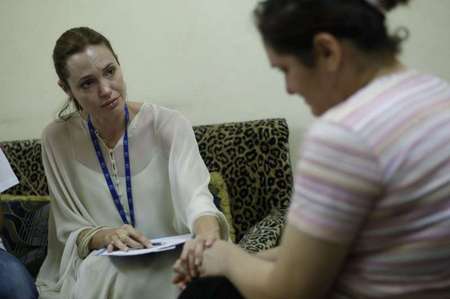
Jon Weinberg is a research intern at the New America Foundation/Middle East Task Force.
A couple of weeks ago, Angelina Jolie, who makes periodic trips as a goodwill ambassador for the United Nations High Commissioner for Refugees (UNHCR), visited Iraqi refugees in southern Damascus along with her partner, Brad Pitt. The purpose of Jolie’s visit was to raise awareness for the plight of those Iraqis displaced since the US-led invasion of Iraq in 2003.
In her own words: “Most Iraqi refugees cannot return to Iraq in view of the severe trauma they experienced there, the uncertainty linked to the coming [January 16, 2010] Iraqi elections, the security issues and the lack of basic services…”
Not surprisingly, Jolie and Pitt’s visit seems to have been largely understood (and sometimes dismissed) as the world’s sexiest couple’s latest humanitarian holiday. Nonetheless, the issue of Iraqi refugees has not gotten the attention it deserves.
According to Refugees International, since March of 2003 more than 1.5 million Iraqis have fled to neighboring countries and 2.7 million Iraqis have become internally displaced. Iraq’s population is around 30 million, about one-tenth that of the US. So, to put those numbers of refugees and displaced persons into perspective, imagine that 27 million Americans were internally displaced and an additional 15 million fled to Canada and Mexico.
Consequently, the Iraqi, Syrian, Lebanese, and Jordanian governments are all faced with a long-term crisis that could easily develop into interminable catastrophe: a large population of permanent refugees.
If this scenario sounds familiar, it is. These same countries (including Iraq) have been dealing with permanent populations of Palestinian refugees since Israel expelled approximately 750,000 Palestinians following the country’s creation in 1948 – a series of events which the Arab world commonly calls al Nakba, “the catastrophe.”
Syria, for instance, has absorbed well over a million Iraqi refugees – about three times the number of Palestinian refugees already living in the country. Roughly speaking, this means that perhaps one of every twenty people living in Syria is an Iraqi refugee. A recent Daily Star article highlights the challenges this situation has forced on the Syrian government:
This huge flood of new arrivals into Syria has put extraordinary pressure on the country’s limited resources. The prices of real estate, food, electricity, kerosene and other commodities have skyrocketed, while the country’s school rooms, clinics and hospitals are strained as a result of overcrowding.
These new pressures are compounded by Syria’s own problems. Unemployment in Syria stands at 9 percent, and despite some development in recent years, poverty remains widespread. The country’s worst drought in decades has forced tens of thousands of Syrian families to leave their farms and head to cities to search for work.
In short, the situation has continued to deteriorate. The plight of Iraqi refugees was a hot news item during the peak of Iraqi internal violence in 2006 and 2007. As the troop surge began to quell violence, however, general interest in the status of refugees cooled off.
Recently, as the American public has grown used to the eventuality of a US withdrawal from Iraq, more questions have begun to arise about resettling Iraqis in the United States. In their recent AP article, Sharon Cohen and Lisa Orkin Emmanuel note that only “about 38,000 Iraqis have come to the United States in the last three fiscal years, compared with just hundreds in the three prior years,” not all of them refugees.
While this figure may seem surprisingly low when compared to the United States’ responsibility for displacing Iraqis in the first place, the small number is not out of line with historical norms. For instance, only 650 Vietnamese citizens arrived in the US between 1950 and 1974 (mostly the wives and children of American servicemen), but hundreds of thousands came after the fall of Saigon in 1975.
What’s more, those who have made it to the United States this year are finding it increasingly difficult to find employment. The International Rescue Committee (IRC) has reported that while it was comparatively simple to find jobs for the mere hundreds of Iraqi refugees who came in 2007, very few of the thousands who have come in 2008 and 2009 are considered self-sufficient.
In the UK, the problem is even worse. Al Jazeera reported yesterday that 40 Iraqi asylum seekers will be sent back to Baghdad this week. This is hardly remarkable considering that “according to Britain’s interior ministry, 632 people were deported to northern Iraq between 2005 and 2008.”
All told, when Syria is arguably doing a better job of handling a humanitarian crisis than the US and the UK, it is fitting to start asking a lot of questions.
— Jon Weinberg


11 comments on “Guest Post by Jon Weinberg: Nakba DéjàVu – The Iraqi Refugee Situation”